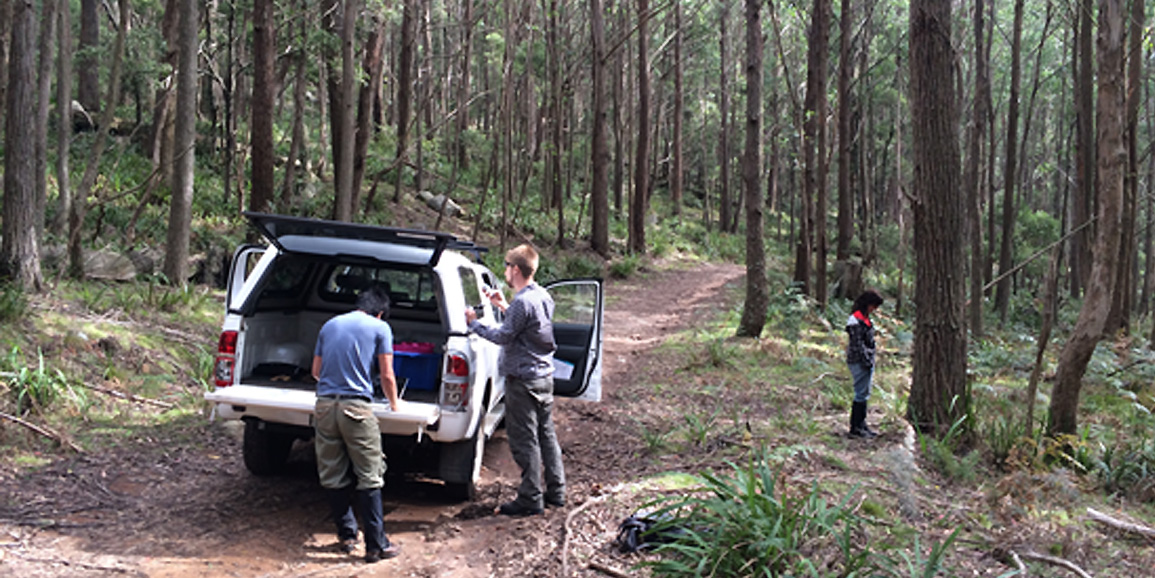
Rowell Group - Population genetics, karyology and phylogeography of terrestrial invertebrates
We study the mechanisms behind the proximal processes of evolution – those that lead to population differentiation, divergence and ultimately speciation.
Research theme
Research themes
Division
About
We are interested in the mechanisms behind the proximal processes of evolution – those that lead to population differentiation, divergence and ultimately speciation. Our group specialises in terrestrial invertebrates because their abundance and low dispersal rates make them excellent models for addressing basic evolutionary principles. Currently we are studying huntsman and funnelweb spiders, fergusonid flies and Onychophora. We use a number of different approaches including the examination of behaviour, morphology, sequence data and chromosomal variation.
Awards
Publications
Selected publications
- Barclay S., Rowell D.M. & Ash J.E. 2000 Pheromonally-mediated colonisation patterns in Onychophora. J. Zool. Lond 250: 437-446
- Rockman M.V. & Rowell D.M. 2002 Episodic chromosomal evolution in Planipapillus: a phylogenetic approach to evolutionary dynamics and speciation. Evolution 56: 58 - 69
- Rowell D.M, Rockman M.V. & Tait N.N. 2002 Extensive Robertsonian Rearrangement: Implications for the radiation and biogeography of Planipapillus Reid (Onychophora : Peripatopsidae). J. Zool. Lond. 257: 171 - 179
- Reinhard J. & Rowell D.M. 2005 Social behaviour in an Australian velvet worm, Euperipatoides rowelli (Onychophora : Peripatopsidae). J. Zool. Lond. 267: 1 - 7
- Gruetzner, F., Ashley T., Rowell D. & Graves J.M. (2006) How did the platypus get its sex chromosome chain? A comparison of meiotic multiples and sex chromosomes in plants and animals. Chromosoma 115: 75 - 88
- Strausfeld N.J., Strausfeld C.M., Stowe S., Rowell D.M. & Loesel R. (2006) Organisation of neuropils in the brain of the onychophoran Euperipatoides rowelli and its evolutionary implications. Arthropod Structure and Development 35: 169 – 196
- Sharp H.E. & Rowell D.M. (2007) Unprecedented chromosomal diversity and behaviour modify linkage patterns and speciation processes: structural Heterozygosity in an Australian Spider. J. Evol. Biol. 20: 2427 - 2439
- Garrick R.C., Rowell D.M., Simmons C.S., Hillis D.M. & Sunnucks P. (2008) Fine-scale phylogeographic congruence despite demographic incongruence in two low-mobility saproxylic springtails. Evolution 62: 1103-1118
- Beavis A.S., Sunnucks P. & Rowell D.M. (2011) Microhabitat preferences drive phylogeographic disparities in two Australian funnel web spiders. Biol. J. Linn. Soc. Lond. 104 : 805-819
- Yip E., Rowell D.M. & Rayor L. (2012) Behavioural and molecular evidence for selective immigration and group regulation in the social huntsman spider, Delena cancerides. Biol. J. Linn. Soc. Lond. 106: 749 - 762
- Garrick R.C., Rowell D.M. & Sunnucks P. (2012) Phylogeography of Saproxylic and Forest Floor Invertebrates from Tallaganda, South-eastern Australia. Insects 3: 270 – 294
- Jeffery N.W., Oliveira I.S., Gregory T.R., Rowell D.M., Mayer G. (2012) Genome size and chromosome number in velvet worms (phylum Onychophora). Genetica, 140: 497-504.
- Bull JK*, Sands CJ*, Garrick RC, Gardner M, Tait NN, Briscoe DA, Rowell DM, Sunnucks P. (2014) Environmental complexity and biodiversity: the multi-layered evolutionary history of a log-dwelling velvet worm in montane temperate Australia. PLoS ONE. 8: e84559. doi:10.1371/journal.pone.0084559




